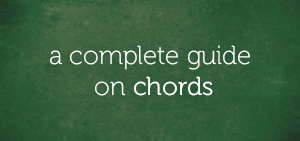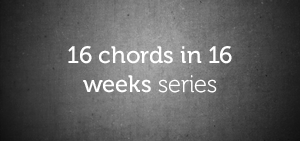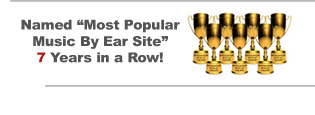On Friday, I introduced “tritone substitutions.”
And by now, you should be a pro at substituting one dominant chord for another.
What’s the trick?
It’s simple. Just figure out what’s a tritone up or down (you’ll land on the same note) from where you’re currently at — then just play that dominant chord instead of your original one.
For example, if you’re playing a G7, the rule simply states to find out what’s a tritone up or down from “G.” The answer is “Db.” Play Db7 in its place and you’ve got yourself a new sound! It’s that easy!
Oh yeah… just in case you don’t know how to play a G7 or Db7 chord (pronounced “G seventh” or “D flat seventh” — or also known as a “dominant seventh” chord), here are the spellings:
G dominant 7: G + B + D + F
Db dominant 7: Db + F + Ab + B (using “B” informally but it would really be C flat (Cb) if this were a music theory exam or something)
So far, we’ve only covered tritone substitutions in “2-5-1” progressions. In other words, you’ve only seen it in action in this setting:
Dminor7 >>> G7 (substitute Db7 here) >>> Cmajor7
Let’s see how tritone substitutions can work in a 1-6-2-5-1 progressions:
1-major7 >>> 6-minor7 >>> 2-minor7 >>> 5-dominant 7 >>> 1-major7
In this past lesson, we talked about using secondary dominant chords on the “2” and “6” chords. Since tritone substitutions work best for dominant chords, let’s change our 2 and 6 chords…
1-major7 >>> 6-dominant7 >>> 2-dominant7 >>> 5-dominant7 >>> 1-major7
In C major, that’s:
C major7 >>> A dominant7 >>> D dominant7 >>> G dominant7 >>> C major7
Now that your minor chords have been changed to dominants, you can pretty much pick your choice! Any of these dominant chords can be candidates for tritone substitutions. (Other types of chords work as well but it’s particularly the way the dominant chord is structured that makes it perfect in these situations.
Notice the tritone in the G7 chord: G + B + D + F. And because there’s really only 6 UNIQUE tritones as we learned in Friday’s lesson, the chord that shares the “other side” of this tritone (F + B) is Db7. That’s why G7 and Db7 can be substituted for each other because they pretty much share two of the same notes — that’s half of their notes!)
So here’s the progression again:
C major7 >>> A dominant7 >>> D dominant7 >>> G dominant7 >>> C major7
And your options…
Option #1: You can choose to play Eb dominant 7 instead of A dominant 7 (Eb is a tritone away from A).
C major7 >>> Eb7 >>> D7 >>> G7>>> C major7
*I tend to like tritone substitutions much better as “tritone follow-ups” (made that up). Instead of replacing “Eb dominant 7” for “A dominant 7,” I’d rather keep the “A dominant 7” and just follow-up quickly with the “Eb dominant 7” to take me to my next chord in the progression. Let’s try that…
C major7 >>> (A7 >>> Eb7) >>> D7 >>> G7 >>> C major7
(So always remember that trick. You don’t have to always substitute. You can use the tritone substitution chord as a follow-up and still add flavor.)
Option #2: You can choose to play Ab dominant 7 instead of D dominant 7 (Ab is a tritone away from D).
Option #3: You can choose to play Db dominant 7 instead of G dominant 7 (Db is a tritone away from G).
Option #4: You can choose to mix and match, substituting two of the three chords (but this gets risky). I wouldn’t go too far or else the real underlying chord progression will be threatened.
So really — for each of these options, you have two choices. You can either do a full substitution (one for the other) or you can do what I call a “follow-up,” keeping both of the chords. But that’s the idea.
So learn your tritones! Learn their relationships! And learn where you can substitute them and you’ll be a forced to be reckoned with!
Until next time —

GospelKeys Tritone Xtravaganza
I've teamed up with my good friend Jamal Hartwell to bring you GospelKeys Tritone Xtravaganza, the course that's finally going to reveal the ins and outs of tritones, how to use them properly, where to place them, and how to take full advantage of their power! Never before has a course focused just on tritones for a whopping 2 hours straight!
GospelKeys Tritone Xtravaganza truly takes you step-by-step and shows you everything you need to know to spice up your contemporary playing with tritones and accompanying chords! Click here to learn more







Comments on this entry are closed.